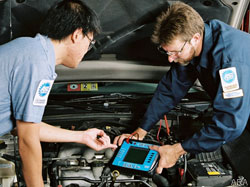
Despite gasoline prices, the old-fashioned auto vacation will once again be a popular choice for families looking for convenience and ready mobility. But with warmer weather come special automotive maintenance challenges – extreme heat, humidity and heavy stop-and-go traffic can cause marginal systems to fail.
The experts at the nonprofit National Institute for Automotive Service Excellence (ASE) offer the following tips on getting your vehicle ready for your vacation:
* Read the owner’s manual and follow the recommended service schedules.
* If you are not a do-it-yourselfer, look for a repair shop with vehicles in the parking lot equal in value to your own, modern equipment in the service bays, and signs of qualified automotive service professionals as evidenced by trade school diplomas, certificates of advanced coursework and training classes, and national certification of the individual technicians by ASE.
* Flush and refill the cooling system (radiator) according to the service manual’s recommendations. The level, condition and concentration of the coolant should be checked periodically. If you are doing your own work, make sure the engine has cooled down before removing the radiator cap and make sure you choose the proper coolant for your vehicle make and model.
* Have engine performance problems — hard starts, rough idling, stalling — corrected. You’ll get better gasoline mileage and you might just prevent more expensive repairs later on. For example, something as simple as a rough idle could indicate an underlying problem that could ruin your vehicle’s catalytic converter over time.
* The tightness and condition of belts, clamps and hoses should be checked by a qualified auto technician. Most do-it-yourselfers do not have the proper equipment.
* Have a marginally operating air conditioner system serviced by a qualified technician. The air conditioners on older vehicles often contain ozone-depleting chemicals that could be released into the air through improper or incompetent service.
* Change the oil and oil filter as specified in the owner’s manual. Properly dispose of used oil. Poll after poll of technicians indicate that this is one of the most neglected services, and one that can greatly reduce the life of your automobile.
* Replace other filters (air, fuel, PCV, etc.) as recommended in the service manual.
* Check the condition of tires, including the spare. Let the tires “cool down” before checking their pressure. Uneven wear, “cupping,” vibrations or “pulling” to one side indicate problems with your tires or suspension system.
* Don’t neglect your transmission. Costly repairs can be prevented by routine service.
* For safety and convenience, inspect all lights and bulbs; replace burned out bulbs. Replace worn wiper blades and keep plenty of washer solvent on hand to fight summer’s dust and insects.
The National Institute for Automotive Service Excellence (ASE) was founded in 1972 as a nonprofit, independent organization dedicated to improving the quality of automotive service and repair through the voluntary testing and certification of automotive technicians. ASE-certified technicians wear blue and white ASE shoulder insignia and carry credentials listing their exact area(s) of certification. Their employers often display the blue and white ASE sign.
Visit www.ase.com for more information, including seasonal car care tips.
Courtesy of ARAcontent





